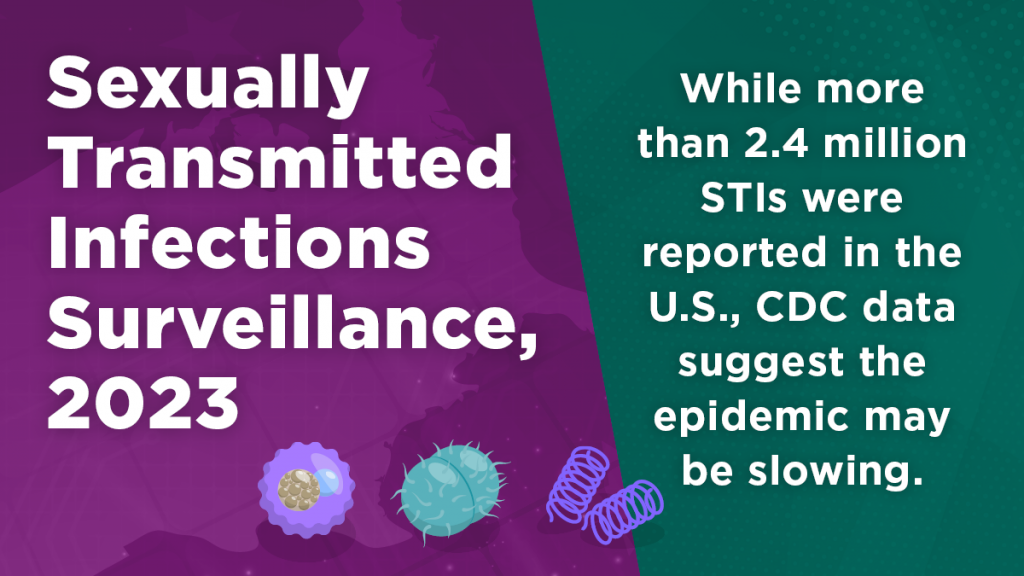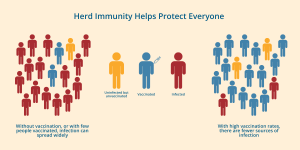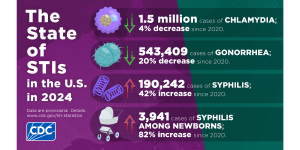
Antibiotic-Resistant Gonorrhea is On the Rise Globally
A new report from the World Health Organization (WHO) warns of rising levels of drug-resistant gonorrhea. The data comes from reported cases of gonorrhea in 12 countries across five WHO regions.

The Centers for Disease Control and Prevention (CDC) just released the 2023 Sexually Transmitted Infections (STI) Surveillance report and for the first time in a long time the data is encouraging. There were fewer STIs reported in the United States last year than the year before; gonorrhea rates fell, chlamydia rates remained stable, and syphilis rates leveled off with only a 1% increase.
This is encouraging and suggests that our public health response to STIs—including new prevention methods and increased testing and treatment—are working. The report, however, is not all good news. Reportable STIs are still 90% higher than 20 years ago, and congenital syphilis is still 7 times higher than a decade ago. Severe disparities also remain with certain groups and geographic areas continuing to be disproportionately affected by the STI epidemic.
These disparities are not about personal behavior. Instead, they stem from societal factors like poverty, stigma, racism, lack of health insurance, and lack of access to quality health care. Until we address the root causes of health disparities, these communities will continue to have higher prevalence of STIs and worse outcomes.
The data suggest that we are on the right track. Increased testing (including the availability of at-home testing), and the introduction of doxy PEP (the use of doxycycline to prevent bacterial STIs) seem to be helping curb the epidemic.
But we can’t stop here, we need to increase prevention, testing, and treatment efforts for everyone. We also need to increase access to prenatal care and syphilis testing during pregnancy to prevent the devastating impact of congenital syphilis on families and communities.
Now is the time to invest in our public health system, increase our workforce, and make STI services more accessible in all communities.

A new report from the World Health Organization (WHO) warns of rising levels of drug-resistant gonorrhea. The data comes from reported cases of gonorrhea in 12 countries across five WHO regions.

We’ve known for years that the HPV vaccine works. Now new research shows that widespread vaccination even protects those who haven’t gotten the shot. This study proves that it is possible to reach herd immunity for HPV.

HPV is one of the most common sexually transmitted infections. Still, finding out that you or your partner has it can feel stressful and confusing. It’s normal to have a lot of questions: What does this mean for our health? Did someone cheat? Should we

The CDC just released STI Surveillance Data for 2024 that show cases of chlamydia, gonorrhea, and syphilis are slowly declining.

Experts say that vaccinating newborns against hepatitis B is one of the most important things we do to protect infants.

Hepatitis is an inflammation of the liver that can be caused by a group of viruses—hepatitis A, B, C, D and E. When hepatitis viruses damage liver cells, scar tissue is formed and those cells can no longer function.

Explore ways to make sex safer and communicate with your sexual partners about your expectations and boundaries.

Why are STI rates so high among young people? For insight we chatted with Dr. J. Dennis Fortenberry, a Professor in the Department of Pediatrics at the Indiana University School of Medicine.
ASHA believes that all people have the right to the information and services that will help them to have optimum sexual health. We envision a time when stigma is no longer associated with sexual health and our nation is united in its belief that sexuality is a normal, healthy, and positive aspect of human life.
ABOUT
GET INVOLVED
ASHA WEBSITES
GET HELP
© 2025 American Sexual Health Association